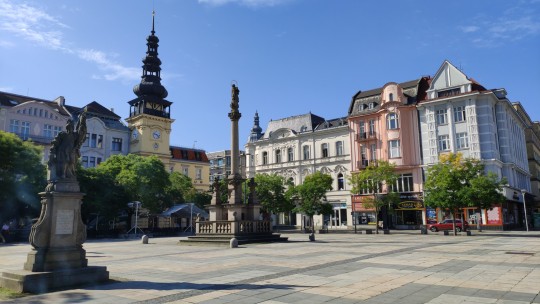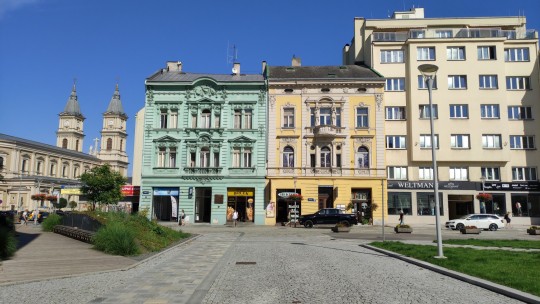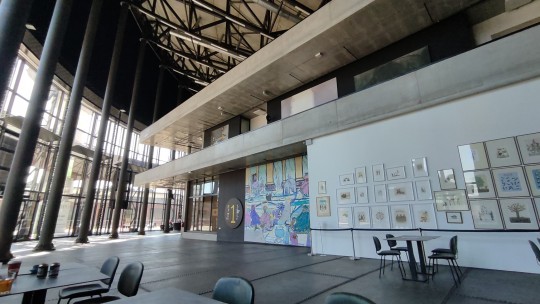#costa rica main attractions
Explore tagged Tumblr posts
Text
✨Top Costa Rica Tourist Destinations 🌴

Costa Rica is a tropical paradise, offering a variety of tourist destinations that attract nature lovers, adventure seekers, and culture enthusiasts alike. Whether you're looking for pristine beaches, lush rainforests, or vibrant cities, Costa Rica has it all. Here’s a look at the top Costa Rica tourist destinations that should be on your travel list. 🌞🌎
1. Arenal Volcano & Hot Springs 🌋💦
Arenal Volcano is one of the most iconic landmarks in Costa Rica, located in the northern part of the country. Visitors flock here to witness its majestic eruptions (though it's currently dormant) and take part in activities like hiking and birdwatching. The nearby hot springs, heated by the volcanic activity, provide a relaxing way to unwind after a day of exploration. The surrounding area is also home to lush rainforests, waterfalls, and diverse wildlife. 🦋🌿
2. Manuel Antonio National Park 🏞️🐒
Manuel Antonio National Park is a must-see destination for nature lovers and wildlife enthusiasts. Located on the Pacific coast, this park is home to beautiful beaches, dense jungles, and rich biodiversity. You can spot sloths, monkeys, iguanas, and colorful birds while strolling through the park’s well-maintained trails. The stunning views of the coastline and the crystal-clear waters make it a perfect spot for swimming, hiking, and sunbathing. 🦥🏖️
3. Monteverde Cloud Forest Reserve 🌫️🌳
For those who love cool weather and mystical landscapes, the Monteverde Cloud Forest Reserve is a dream destination. Nestled in the mountains, this reserve is covered in a thick layer of mist, giving it an ethereal quality. It’s an ideal place for hiking, zip-lining, and birdwatching. Don’t forget to look out for the famous Resplendent Quetzal, a brightly colored bird that’s a rare sight in other places. 🌱🦜
4. Tamarindo Beach 🏄♀️🌊
Tamarindo Beach is one of Costa Rica’s most popular coastal destinations, attracting surfers from around the world. The beach offers consistent waves, making it ideal for surfing at all levels. In addition to surfing, visitors can enjoy relaxing on the golden sands, take part in water sports, or explore nearby towns and restaurants. Tamarindo also has a vibrant nightlife, so you can enjoy sunset cocktails and live music in the evening. 🏖️🌅
5. Tortuguero National Park 🐢🌿
Known as the “Amazon of Costa Rica,” Tortuguero National Park is a network of canals, wetlands, and dense rainforests on the Caribbean coast. This park is famous for its sea turtle nesting sites, where thousands of turtles come ashore to lay their eggs. In addition to turtles, Tortuguero is home to a wide range of wildlife, including monkeys, sloths, and jaguars. Explore the park by boat, gliding through the waterways and spotting wildlife in their natural habitat. 🐊🐢
6. Corcovado National Park 🏞️🐾
Corcovado National Park is located on the Osa Peninsula and is often considered one of the most biodiverse places on Earth. The park is home to various ecosystems, from rainforests to wetlands and beaches, which house a wide array of wildlife. Visitors can take guided tours to see everything from tapirs to scarlet macaws and experience the raw beauty of Costa Rica’s wilderness. It’s an off-the-beaten-path destination, perfect for those looking for adventure and seclusion. 🦓🦋
7. San José – The Heart of Costa Rica 🏙️
Don’t miss the capital city, San José, if you want to experience Costa Rica’s vibrant culture and history. From the National Theatre to the Gold Museum, there’s plenty to see and do in this bustling city. San José is also a gateway to the rest of the country, making it a convenient stop for travelers. You can explore its local markets, sample traditional Costa Rican food, and soak up the lively atmosphere. 🍴🏛️
Costa Rica’s diverse tourist destinations offer something for everyone, from thrilling adventures in nature to relaxation on beautiful beaches. No matter where you go, you’ll experience the country’s famous hospitality and breathtaking landscapes. 🌅🌟
#costa rica travel agency#costa rica travel companies#travel agency costa rica#costa rica tourist areas#costa rica tourist spots#costa rica tourist sights#costa rica main attractions
1 note
·
View note
Text
Day 12 - Ostrava (Czechia)
It's definitely summer today in Ostrava. It's the first day in this entire trip where I felt the need to wear a tank top, and I honestly hope it's not gonna get hotter than this XD

The city center is very nice in the sun, filled with colorful buildings. There's still not so many people around, but the city is not empty.

Ostrava is an industrial city, and the main attraction that every guide tells you to visit is Dolní Vítkovice, and it's a good thing they do because it's kind of amazing.

Have you ever looked at an abandoned factory and wished you could go wander inside the compound? Well in Dolní Vítkovice you can! It's a massive steel working+coal mine that was in operation until the 90s, and now you can visit, learn about the history and the technical aspects, or just vibe with the aesthetic XD


There are museums, a gallery and cafes inside and it's basically a cool neighborhood you can hang out in. 10/10 would visit again (also maybe don't come on Monday because many things are closed on Monday XD).

After seeing it many times on the menu, it's finally the right temperature to try an espresso tonic (a cold espresso with tonic water). And, no. I did not think it was the right combo for me and it wasn't. Damn my curiosity XD
Next stop: Landek park. There's a mining museum here, but it's very hot and the park looks so appealing with its trees and shade, and I don't really need to visit another mining museum (I visited one in Wales years ago with a very good tour guide), so instead I head into the wooden path.

I get a pomelo and grapefruit birell (which is a Czech non alcoholic beer - I wish I knew it was non alcoholic before because it's as inexpensive as beer and I would have gotten it many other times instead of spending all my money on water or sodas XD) and just enjoy the green and the breeze for a while.

The walk through the park is very nice, though sadly the path is very close to a highway and most of what you hear is traffic.
I was very lucky and not only is today the first day of Ostrava's folklore festival but the first event is basically next to the place I'm staying <3

It's mostly dance focused (I thought it was going to be musicians) and though most performers are Czech or from neighbouring countries there are also a couple of acts from farther away (China, Costa Rica). I love that it started in the afternoon!

#ostrava#czechia#czech republic#europe#travel#it's not technically interrail 2023#mag travels from time to time#my photography#i just want a tag for the things i personally put out into the world
30 notes
·
View notes
Note
vareity posted about a cr tip, do you guys know anything? // i know someone who works at the L.A. office. this was the tip:
Chris Evans is going to be in Costa Rica from May 16 - June 1 2023, along with producers from MGM.
Said producers are trying to get legalities accepted to obtain filming rights in the following locations: Cartago, Costa Rica, Heredia, Costa Rica, Isla Tortuga, Costa Rica, Monte Verde, Costa Rica, TBA.
The main locations the production team has their eyes on is Basílica de Nuestra Señora de los Ángeles—the popular tourist attraction Cathedral in Cartago, Costa Rica—as well as Isla Tortuga.
Isla Tortuga may be a bit more difficult to have approved rights for as the turtle population may be put at risk due to filming.
Oddly enough, we got information about this almost a month ago. I forgot about it until now. For a minute we thought we were being trolled, but it looks like we weren’t. Considering the news is now out, I figured I’d share the ask (my apologies to the anon if this wasn’t ok to share yet) 🦎


11 notes
·
View notes
Photo




San Lucas Island Prison
It seems the Ghost Hunters International team has become fascinated in investigating the penal system around the world. Their next stop is San Lucas Island in Costa Rica. This island’s history horror began in the 16th Century. The Spanish conquistador Gonzalo Fernandez Oviedo used San Lucas as a concentration camp for local Chara people. These people were slaughtered on the site of their sacred burial grounds.
A few hundred years later, San Lucas was turned in to a penal island. The prison was constructed in 1873 by dictator Tomás Miguel Guardia Gutiérre. It was dubbed the Caribbean Alcatraz. However, San Lucas also didn’t achieve the inescapable label so many prisons sought. There were many daring escapes to shark infested waters and tragic failures. But then again who wouldn’t want to attempt freedom from one of the most heinous prisons known to man.
Only the worst criminals in Costa Rica were sent to San Lucas. The prison was considered the largest in the country’s history. The former buildings include a historic dock that is still in use after the first dock was destroyed, a Catholic church, a medical building, temporary holding cells, a three story main office, a large concrete disc used to hold a water tank, and water pumps. There are also several water pumps and a cemetery under excavation on the island. There are prison cells of varying security levels, containing the typical graffiti such as religious phrases, pornographic images, signatures, and drawings. The above statement is written in one of these cells.
The death penalty was abolished by Gutiérre a year after the prison opened its doors. However, with such prison conditions, a stint in San Lucas was a death sentence in itself. Sixty to a hundred inmates occupied one cell at time. Cells contained low ceilings, few windows, and iron beds with thin mattresses. Those without a bed slept on the floor. Each prisoner was issued a ball and chain. The weight of the ball was determined by how dangerous the inmate was deemed to be.
Inmates labored in the tropical sun, breaking rocks and harvesting salt from the sea. “The Disk” sits in the center of the prison courtyard. In the middle is a hole half filled with water. This was considered solitary confinement. Some inmates spent months in there with only 15 minutes above ground each day. A former inmate, José León Sánchez, wrote a fictional account of his incarceration at San Lucas titled La Isla de Hombres Solos or The Lonely Men’s Island. The prison remained operational until 1991. The island has since been turned in to a wildlife preserve and San Lucas is now opened as a tourist attraction.
Many believe the former inhabitants of this maximum security facility are still roaming the property.
#San Lucas Island Prison#haunted prison#haunted locations#paranormal#ghost and hauntings#ghost and spirits#haunted salem#myhauntedsalem
6 notes
·
View notes
Photo

DISCOVER PUERTO RICO UNVEILS RESULTS OF VISITORS PROFILE STUDY
Island Scores High Marks with Business and Leisure Guests; Golf, Beaches, Culture, and Gastronomy Contribute to Satisfaction, Intention to Return
Discover Puerto Rico published its first comprehensive study on visitors arriving in Puerto Rico, a year-long assignment that included interviews in different parts of the Island with 1,607 travelers from abroad.
One of the study’s main findings is that 98% of visitors were satisfied with their experience on the Island.
Similarly, 95% estimate they will return in the future, and less than 15% experienced any concerns at some point during their stay.
The Island has long been popular with golfers, beach lovers, and those who appreciate the Island’s culture, biodiversity, and people. Now, according to the study results, visitors have expanded the reasons they choose Puerto Rico for getaways and travel experiences.
The main reason for travel was vacationing (65%). Only 13% said their trip was to visit relatives or friends.
Travelers selected Puerto Rico as a destination for its weather (34%), scenic beauty (32%), and local
culture (31%).
On average, travelers stayed on the island for 6.1 nights. About half spent the night in a hotel (45%), a
third in short-term rentals (34%), and the rest in private residences. It is estimated that each visitor spends around $208 per day. These expenses include accommodations, food, entertainment, experiences, and shopping.
This picture shows the composition of travelers in the best year in the history of the tourism industry in
terms of total visitor spending ($8.9 billion), revenue from the rental tax ($116 million), and jobs in the
recreation and lodging sectors (91,500). 2022 generated the highest passenger traffic at Luis Muñoz
Marín airport (over 10 million) in more than a decade.
The increased visitation certainly has resonated throughout the Island golf destination, as many courses and golf resorts report welcoming burgeoning numbers of players in each of the past three years.
Sixteen of Puerto Rico’s 18 golf courses are open to the public. The other two – at TPC Dorado Beach – allow play by guests staying at the Dorado Beach, Ritz-Carlton Reserve. Golfweek rates several of the Island’s courses among the best in the Caribbean, Mexico, Costa Rica and the Atlantic Islands.
Island courses range from luxury resort to municipal, spread throughout Puerto Rico with several clustered near historic San Juan. Oceanside views, coconut trees, and mountain and rainforest vistas frame their settings. Price points, terrain, layout style, and related amenities are varied and complementary.
Traveling to the Island is convenient with many choices as it is the air hub of the Caribbean. Further traveler friendliness is found in Puerto Rico’s bilingual culture, U.S. currency, and no passport required for American citizens.
For more information on the Island, travel guidelines, golf courses, resorts and hotels, and other destination attractions, visit DiscoverPuertoRico.com
6 notes
·
View notes
Text
El Salto Rope Swing: A Thrilling Dive into the Heart of Costa Rica

Facilities
El Salto Rope Swing is a natural attraction, not a commercialized park.
Basic Amenities: While there are no formal facilities, the area provides a rustic charm.
Parking: Limited parking is available along the roadside, but be mindful of local traffic.
Restrooms: There are no restrooms available at the site.
Best Time to Visit
Dry Season (December-April): Offers the best weather for swimming and enjoying the outdoors.
Green Season (May-November): While rain showers are more frequent, the lush greenery adds to the tropical ambiance.
How to Reach El Salto Rope Swing
From La Fortuna: El Salto is easily accessible from La Fortuna, the main town in the Arenal Volcano region. It’s a short drive or a scenic walk along the Río Fortuna.
By Car: If driving, follow the signs towards La Fortuna Waterfall. The swing is located just before the waterfall entrance, on the right-hand side of the road.
By Taxi: Taxis are readily available in La Fortuna and can easily take you to El Salto.
By Foot: If you’re feeling adventurous, a leisurely walk along the riverbank from La Fortuna will lead you to the swing.
Top Activities
The Thrill of the Swing: The main attraction, of course, is the exhilarating rope swing. Feel the adrenaline rush as you soar through the air and plunge into the refreshing waters below.
Swimming in the Río Fortuna: The crystal-clear waters of the Río Fortuna offer a perfect opportunity for a refreshing swim.
Sunbathing and Relaxation: Relax on the riverbank, soak up the sun, and enjoy the peaceful ambiance.
Nature Photography: Capture the stunning scenery, including the lush rainforest, the dramatic cliffs, and the powerful river.
Birdwatching: The area surrounding El Salto is home to a diverse array of bird species. Keep your eyes peeled for colorful toucans, vibrant parrots, and other fascinating avian life.
Read More:
Waterfalls in Costa Rica
Ojochal Costa Rica
Montezuma Waterfalls
Llanos De Cortez Waterfall
La Leona Waterfall
Oropendola Waterfall
Best Area To Stay In Costa Rica
Nearest Tourist Places
La Fortuna Waterfall: A short distance from El Salto, this magnificent waterfall cascades down a volcanic cliff face, creating a breathtaking spectacle.
Arenal Volcano National Park: Explore the diverse ecosystems of this national park, including rainforests, lava flows, and volcanic hot springs.
Hot Springs: Indulge in a relaxing soak in one of the many natural hot springs in the area.
Arenal Lake: Enjoy water activities such as kayaking, paddleboarding, and boat tours on this picturesque lake.
Hanging Bridges: Walk through the rainforest canopy on a series of suspension bridges, offering unique perspectives of the surrounding flora and fauna.

Where to Stay Near El Salto
La Fortuna offers a wide range of accommodation options to suit every budget and preference.
Luxury Hotels: Enjoy world-class amenities and stunning views at luxury resorts and lodges.
Eco-Lodges: Immerse yourself in nature at eco-friendly lodges that prioritize sustainability.
Budget-Friendly Options: Find affordable options such as guesthouses, hostels, and budget hotels.
Vacation Rentals: Consider renting a villa or apartment for a more independent and spacious stay.
Tips for Visiting El Salto Rope Swing
Wear appropriate footwear: Water shoes or sandals are recommended for navigating the rocky riverbed.
Bring sunscreen, insect repellent, and a hat: Protect yourself from the sun and insects.
Stay hydrated: Bring plenty of water to stay refreshed, especially during hot weather.
Respect the environment: Leave no trace and dispose of your trash properly.
Be mindful of others: Share the space and be considerate of other visitors.
Check local conditions: Before visiting, inquire about any potential weather advisories or river conditions.
El Salto Rope Swing is more than just a tourist attraction; it’s an experience that captures the essence of Costa Rica — adventure, natural beauty, and the spirit of “Pura Vida.” Embrace the thrill, immerse yourself in the natural surroundings, and create memories that will last a lifetime.
Here are some FAQs about El Salto Rope Swing
Q: What is El Salto Rope Swing?
A: El Salto Rope Swing is a popular tourist attraction in Costa Rica where you can swing over the Río Fortuna and plunge into the water below.
Q: Where is El Salto Rope Swing located?
A: It’s located near La Fortuna Waterfall in the Arenal Volcano region of Costa Rica.
Q: Is there an entrance fee for El Salto Rope Swing?
A: No, there is typically no entrance fee. However, it’s customary to leave a small tip for the locals who maintain the swing.
Q: Can I swim in the Río Fortuna?
A: Yes, the river is a popular spot for swimming.
Q: What should I wear to El Salto Rope Swing?
A: Wear comfortable clothing that can get wet, such as swimwear and water shoes.
Q: Are there any age restrictions for the rope swing?
A: While there are no official age restrictions, it’s generally recommended for those who are comfortable with heights and physical activity.
Q: What other activities can I do in the area?
A: Visit La Fortuna Waterfall, explore Arenal Volcano National Park, relax in hot springs, and enjoy water activities on Arenal Lake.
#elsaltoropeswing#Elsaltoropeswingdeath#Elsaltoropeswingcost#Elsaltoropeswingcostarica#ItineraryPlans
0 notes
Text
Get Ready for the Best Hermosa Surfing Vacation in Costa Rica
Learn lessons in surfing on Hermosa Beach, Playa Hermosa is one of the popular surfing beaches near Jaco Costa Rica. This location offers a variety of wave conditions for surfing to visitors, Playa Hermosa is known for amazing wave conditions this beach comes with 4 miles of black sand. If you want to learn Hermosa Surfing lessons look no further, Playa Surf Camp offers surfing excursions. Visitors can learn surfing under the guidance of a professional whether you are a beginner or experienced the guide will make you learn accordingly. Many accommodations are available to stay right on the beach for travelers with luxury amenities and facilities. The staff of the property rentals is expert and will make your vacation dream into reality.
In addition, explore Guys trip Jaco with lots of adventures and outdoor activities such as wedding celebrations, bachelor parties, events, fishing, concierge services, tours, private chef, golf, massage, surfing, zipline, ATV, rafting, paragliding, nightlife, party boats, pool party, chauffeur, Tortuga island, helicopter rides and so on. After exploring these activities travelers will never forget this tremendous holiday experience. Explore local attractions of Costa Rica like Manuel Antonio National Park, one of the most popular national parks known for its rich biodiversity. For more booking details, click on the linked text and it will redirect you to the main website of the owner so that you can book vacation villa rentals easily without any hassle. We wish you a happy and secure holiday!
0 notes
Text
Why Choose a Costa Rica Engagement and Wedding Photographer from Wedding Photography Toh Gouttenoire
Costa Rica, with its lush landscapes, pristine beaches, and vibrant culture, offers a breathtaking backdrop for engagement and wedding photography. For couples planning their special day in this stunning destination, hiring a skilled Costa Rica engagement and wedding photographer is essential to capture every magical moment. Wedding Photography Toh Gouttenoire provides exceptional photography services that immortalize love stories in one of the most beautiful locations in the world.
The Allure of Costa Rica for Engagement and Wedding Photography
Costa Rica’s natural beauty is one of its strongest attractions for couples seeking a destination wedding or engagement photoshoot. From the lush rainforests and towering volcanoes to the white-sand beaches of the Pacific Coast, the country offers a variety of stunning settings for wedding and engagement photos. Whether you're exchanging vows on a beach at sunset or capturing intimate moments surrounded by tropical greenery, Costa Rica is the perfect canvas for creating unforgettable memories.

A Costa Rica engagement and wedding photographer is crucial for making sure that these moments are beautifully captured. With the right photographer, couples can relive the magic of their special day for years to come.
Why Wedding Photography Toh Gouttenoire Stands Out
Wedding Photography Toh Gouttenoire is a premier photography service specializing in engagement and wedding photography in Costa Rica. With years of experience, the company understands the unique beauty of the country and knows how to make the most of its diverse landscapes. Their photographers are experts in capturing natural, authentic moments while also creating stunning, artistic compositions.
What sets Wedding Photography Toh Gouttenoire apart is their commitment to personalized service. Each couple’s vision is at the heart of their photography style. The team takes the time to get to know the couple, understand their style, and what they hope to convey through their photos. This personalized approach ensures that each shoot reflects the couple’s unique personalities, love, and the beauty of Costa Rica itself.
The Benefits of Professional Engagement and Wedding Photography
One of the main advantages of hiring a Costa Rica engagement and wedding photographer is the professional experience they bring. Wedding Photography Toh Gouttenoire’s team has the technical skills and artistic vision necessary to handle various lighting conditions and weather changes, which are common in a tropical climate. They know how to use the environment to enhance the photographs, creating images that are not only technically sound but also visually captivating.
Conclusion
Choosing the right Costa Rica engagement and wedding photographer is essential for preserving the memories of your special day. With Wedding Photography Toh Gouttenoire, you get a team of skilled professionals who are dedicated to making your wedding experience unforgettable. Their expertise in capturing the beauty of Costa Rica’s landscapes, combined with a personalized approach to photography, ensures that your love story will be beautifully documented for generations to come. Whether you’re planning a romantic engagement shoot or a grand wedding, Wedding Photography Toh Gouttenoire is the ideal partner for capturing the magic of your Costa Rica celebration.
0 notes
Text
What to do in Rio Celeste Special? Top Things You Haven’t Thought of Doing
When it comes to natural wonders, Rio Celeste in Costa Rica holds an unmatched charm. Nestled within the lush greenery of Tenorio Volcano National Park, this vibrant turquoise river is a spectacle of nature’s artistry. While the Rio Celeste Waterfall often steals the spotlight, there are numerous unique activities that visitors can enjoy to truly experience the magic of this enchanting destination. Here, we’ll explore what makes Rio Celeste special and the top things you may not have thought of doing during your visit.

Witness the Magical Transformation at Los Tenideros
Here are some light on what to do in rio celeste. Rio Celeste’s signature turquoise color is more than just a visual treat—it’s a scientific wonder. At Los Tenideros, where two clear rivers merge, the water undergoes a chemical reaction between volcanic minerals, resulting in the iconic blue hue. Visiting this spot is like watching nature perform a magic trick, as the water shifts from crystal-clear to strikingly blue. It’s a sight that will leave you mesmerized and one that sets Rio Celeste apart from other natural attractions.
Explore the Trail Less Traveled
While most visitors stick to the main trail leading to the waterfall, venturing off to lesser-known paths can reveal hidden gems. The park offers a network of trails that wind through dense rainforests, bubbling thermal springs, and volcanic fumaroles. Each step unveils new surprises, from unique flora to glimpses of wildlife like sloths, toucans, and colorful frogs. For those who love solitude and discovery, these trails offer an opportunity to connect with nature in a more personal way.
Take a Tubing Adventure on the Rio Celeste
One of the most exhilarating ways to experience Rio Celeste is by floating down the river on a tubing tour. Guided tubing adventures provide a fun and refreshing way to explore the river’s turquoise waters while soaking in the surrounding beauty. As you gently drift through the calm stretches and navigate mild rapids, you’ll feel immersed in the pristine environment. Tubing is a unique activity that combines relaxation and adventure, making it an unforgettable part of your Rio Celeste experience.
Visit the Blue Lagoon
The Blue Lagoon, a serene pool along the Rio Celeste, is another hidden gem that many visitors overlook. The tranquil waters of the lagoon reflect the vibrant blue hue of the river, creating a picturesque setting perfect for photography or simply soaking in the beauty. Although swimming is not allowed to preserve the delicate ecosystem, the Blue Lagoon is a must-visit spot for those seeking peace and serenity amidst nature.
Experience Local Culture in Bijagua
The nearby town of Bijagua serves as a gateway to Rio Celeste and offers a glimpse into Costa Rica’s local culture. Here, you can explore small family-run cafes serving traditional Costa Rican dishes, visit local markets, and interact with friendly locals. Bijagua is also home to several eco-lodges, where you can enjoy comfortable accommodations while staying close to nature. Spending time in this charming town adds a cultural dimension to your Rio Celeste trip.

Soak in Natural Hot Springs
After a day of hiking and exploring, there’s no better way to relax than soaking in one of the region’s natural hot springs. The geothermal activity of the Tenorio Volcano heats these springs, providing a soothing and therapeutic experience. Surrounded by lush greenery, the hot springs offer a peaceful retreat where you can unwind and rejuvenate.
Discover Wildlife in Its Natural Habitat
Tenorio Volcano National Park is a haven for wildlife enthusiasts. The park’s diverse ecosystems are home to a wide array of animals, including capuchin monkeys, coatis, iguanas, and countless bird species. Guided tours often include wildlife spotting, with expert guides helping you locate and identify the park’s elusive inhabitants. For photographers and nature lovers, this is a chance to capture unforgettable moments in the wild.
Learn About the Park’s Geology and Ecology
For those curious about the science behind Rio Celeste’s wonders, guided tours provide fascinating insights into the park’s geology and ecology. Learn about the volcanic processes that shape the landscape, the unique chemical composition of the river, and the delicate balance of the surrounding rainforest ecosystem. These tours not only enhance your appreciation of Rio Celeste but also highlight the importance of conservation efforts to preserve this natural treasure.
Practical Tips for Visiting Rio Celeste
To make the most of your visit, consider the following tips:
Arrive Early: Early mornings are the best time to avoid crowds and enjoy the park’s tranquility.
Wear Comfortable Footwear: Hiking boots or sturdy shoes are essential for navigating muddy trails.
Pack Essentials: Bring water, snacks, sunscreen, insect repellent, and a lightweight rain jacket.
Respect the Environment: Follow park rules and leave no trace to help protect the delicate ecosystem.
Hire a Guide: Local guides offer valuable knowledge and ensure you don’t miss any highlights.
Why Rio Celeste Should Be on Your Bucket List
Rio Celeste is not just a destination; it’s an experience that stays with you long after you’ve left. Its vibrant turquoise waters, lush surroundings, and unique activities create a sense of wonder and awe that’s hard to find elsewhere. Whether you’re hiking through the rainforest, marveling at the waterfall, or floating down the river on a tubing adventure, Rio Celeste offers countless moments of magic.
If you’re planning a trip to Costa Rica, make sure to include Rio Celeste in your itinerary. With its stunning natural beauty and a variety of activities that cater to all interests, it’s a destination that promises unforgettable memories. Discover what makes Rio Celeste special and let it become the highlight of your Costa Rican adventure.
0 notes
Text
Jungle Safari tours,
Jungle Safari tours,
Jungle Safari tours offer an exhilarating escape into the heart of nature, providing travelers with a unique opportunity to explore some of the most biodiverse and pristine regions of the world. From dense forests to sprawling savannahs, these tours offer a chance to witness wildlife in their natural habitats, experience remote landscapes, and create unforgettable memories.
The Appeal of Jungle Safaris
Jungle safaris have grown in popularity due to the allure of discovering untouched wilderness and observing wildlife up close. Whether you're a seasoned adventurer or a nature enthusiast, the prospect of exploring jungles, rainforests, and wildlife reserves can be incredibly enticing. These tours cater to a wide range of travelers—from those seeking thrilling encounters with big cats and elephants to bird watchers and botanists interested in the rich biodiversity of these ecosystems.
Types of Jungle Safari Tours
Safari by Land Land-based jungle safaris typically involve guided jeep or walking tours through dense forests and open plains. Popular destinations like Africa's Serengeti, India’s Bandhavgarh, and Costa Rica’s lush jungles offer opportunities to spot iconic wildlife such as lions, tigers, elephants, and rhinos.
River and Water-based Safaris For those interested in exploring waterways, river safaris provide a unique perspective. Boats and canoes navigate through winding rivers and waterways, offering a chance to spot crocodiles, hippos, and a variety of bird species.
Trekking and Hiking Trekking safaris immerse travelers deep into the heart of the jungle. Hikes through dense trails offer encounters with elusive wildlife and often lead to breathtaking views of remote landscapes. Trekking in destinations like the Amazon rainforest or Madagascar can be especially rewarding for those seeking solitude and adventure.
Wildlife Encounters and Cultural Experiences Some jungle safari tours blend wildlife viewing with cultural experiences. In regions like Africa and Southeast Asia, visitors have the chance to interact with local communities and learn about their traditions, contributing to a deeper understanding of the region's heritage.
Wildlife and Biodiversity
One of the main attractions of jungle safaris is the opportunity to witness incredible wildlife in their natural habitats. The vast jungles of Africa, Asia, South America, and Oceania are home to an astonishing array of species, many of which cannot be seen anywhere else.
Big Cats: Lions, tigers, leopards, and cheetahs are some of the most sought-after sightings in various safari destinations.
Elephants and Rhinos: These majestic creatures are iconic symbols of the wild, with populations concentrated in Africa and Asia.
Primates: Monkeys, orangutans, and other primates are commonly observed in dense rainforests.
Birdlife: Jungle safaris offer opportunities to spot colorful and rare bird species, making it a paradise for birdwatchers.
Reptiles and Amphibians: From snakes to crocodiles, the diversity of reptiles and amphibians adds another layer of intrigue to jungle safaris.
Preparation for Jungle Safaris
Before embarking on a jungle safari tour, careful preparation is key to ensuring a safe and enjoyable experience. Here are some essential tips:
Travel Essentials: Pack lightweight, moisture-wicking clothing, sturdy hiking boots, and a waterproof jacket. Don’t forget essentials like insect repellent, sunscreen, and a good pair of binoculars for spotting wildlife.
Safety Precautions: Jungle environments can be unpredictable, so staying informed about local safety guidelines is crucial. Hiring experienced guides or joining organized tours ensures that you have knowledgeable experts to lead the way.
Eco-Friendly Practices: Many destinations are eco-sensitive, so travelers are encouraged to respect local conservation efforts. Choose tour operators who prioritize sustainable tourism and conservation practices.
Health Considerations: Some jungle areas are located in remote regions, and health risks such as mosquito-borne diseases should be taken seriously. Vaccinations, medications, and travel insurance are recommended.
Best Destinations for Jungle Safaris
Africa
Serengeti National Park (Tanzania): Famous for the Great Migration, it offers excellent chances to see the "Big Five" (lion, elephant, buffalo, rhino, and leopard).
Kruger National Park (South Africa): A premier destination for wildlife viewing, including the rare white rhino.
Okavango Delta (Botswana): A lush oasis in the Kalahari Desert, rich in wildlife and scenic waterways.
Asia
Bandhavgarh National Park (India): Known for its large tiger population.
Sundarbans (India/Bangladesh): A mangrove forest and UNESCO World Heritage Site, famous for its Bengal tigers.
Borneo and Sumatra (Indonesia): Home to orangutans and diverse rainforest landscapes.
South America
Amazon Rainforest (Brazil, Peru, Colombia): The largest and most famous tropical rainforest, teeming with biodiversity.
Pantanal (Brazil): One of the world's largest wetland systems, ideal for spotting jaguars and other wildlife.
Oceania
Daintree Rainforest (Australia): A UNESCO World Heritage Site with unique flora and fauna.
Papua New Guinea: Remote and rich in biodiversity, offering opportunities to see rare species like the birds of paradise.
Conclusion
Jungle safari tours offer thrilling adventures into the wild, providing opportunities to witness extraordinary landscapes and remarkable wildlife. Whether you’re drawn by the awe of big cats, the wonders of birdlife, or the beauty of pristine rainforests, jungle safaris are an adventure of a lifetime. With proper planning, respect for nature, and an open mind, travelers can embark on journeys that leave lasting impressions and contribute to conservation efforts around the globe.
4o mini
O
0 notes
Text

ocean view vacation homes Costa Rica
RADS Vacation Rentals provides stunning properties like the Punta Mala, where you can unwind in a spacious home while enjoying breathtaking coastal views. These fully furnished vacation homes are designed for comfort, featuring modern amenities such as well-equipped kitchens, ample living spaces, and proximity to both natural beauty and exciting local attractions. Whether you’re visiting for a family vacation or a romantic getaway,
#ocean view vacation homes Costa Rica#Vacation#rsdsvacationrentals#home#villa#home & lifestyle#Travel#Ocean view#Costa rica
0 notes
Text
Discovering Unforgettable Escapes with Expedia Getaway Packages
Expedia, one of the world’s leading online travel companies, has redefined vacation planning for millions of travelers worldwide. Their versatile platform offers everything from flight bookings and hotel reservations to car rentals and travel insurance. However, one of Expedia’s standout features is its array of getaway packages, which combine flights, accommodations, and sometimes even car rentals or activities, all at a discounted rate. In this article, we’ll explore what makes Expedia’s getaway packages exceptional, highlight popular destinations, and offer tips on how to get the most value from these deals.
Why Expedia Getaway Packages Are a Game-Changer
Expedia’s getaway packages are designed to simplify the travel planning process while delivering significant savings. By bundling essential travel services, they enable travelers to save up to hundreds of dollars compared to booking each component separately. Let’s delve into why these packages are a must-see for any vacationer.
a) Cost Savings
One of the main reasons travelers choose Expedia’s getaway packages is the potential for substantial savings. Bundling flights, hotels, and sometimes rental cars or activities, Expedia offers exclusive package prices that often come in well below the cost of booking each part individually. This bundling process allows Expedia to negotiate better rates, passing those savings along to the customer.
b) Convenience and Efficiency
Expedia’s platform allows travelers to browse through thousands of destinations, compare package options, and book their entire trip in just a few clicks. Rather than jumping between multiple websites to find flights, hotels, and rental cars, travelers can do it all on one user-friendly platform.
c) Customization Options
Expedia understands that no two travelers are alike. Whether you’re looking for a luxury escape, a budget-friendly trip, or something in between, Expedia offers extensive filters and options to customize packages. You can select the specific type of accommodations, the duration of your stay, and even opt for unique experiences in your destination city.
d) Added Perks
Expedia’s partnerships with hotels, airlines, and local operators often allow it to include additional perks with its getaway packages, like complimentary breakfast, early check-ins, and spa credits. Expedia Rewards members can also earn points on every booking, which can be redeemed for discounts on future trips, adding another layer of value to these packages.
2. Popular Types of Getaway Packages on Expedia
Expedia caters to a wide array of travelers, offering packages that suit various interests, budgets, and travel styles. Here are some popular categories of getaway packages that attract different types of travelers:
a) Romantic Escapes
Expedia offers thoughtfully curated packages for couples seeking a romantic retreat. Destinations like the Caribbean, Hawaii, and Paris are frequent favorites, with packages that include luxury accommodations, romantic dinners, and exclusive tours. For honeymoons or anniversaries, these packages often include special touches, such as champagne on arrival or couples’ spa treatments.
b) Family-Friendly Packages
For families, Expedia provides a range of packages to family-friendly destinations such as Orlando, San Diego, and Cancun. These packages are designed with children in mind, offering accommodations at family-friendly hotels and access to popular attractions like amusement parks, zoos, and aquariums.
c) Adventure and Outdoor Packages
For thrill-seekers, Expedia offers packages to destinations known for adventure activities, such as Costa Rica, Colorado, and the Swiss Alps. These getaway packages often include activities like hiking, white-water rafting, skiing, or zip-lining, giving adventure enthusiasts everything they need to have an unforgettable experience.
d) City Breaks and Cultural Experiences
For travelers who love exploring urban landscapes and immersing themselves in local culture, Expedia has packages focused on major cities like New York, Tokyo, and London. These city-centric packages may include guided city tours, museum tickets, and passes to popular landmarks, making it easy to see the best each city has to offer.
e) Relaxation and Wellness Retreats
Expedia’s wellness-focused packages are perfect for travelers seeking relaxation. These often feature destinations like Bali, Thailand, and Sedona, and may include stays at spa resorts with wellness activities like yoga, meditation, and healing therapies. These packages make it easy for travelers to unwind, recharge, and return home refreshed.
3. Top Destinations for Expedia Getaway Packages
Expedia’s reach is vast, covering destinations around the globe. Here are some of the top destinations where travelers can find excellent deals and unforgettable experiences:
a) Hawaii, USA
A perennial favorite, Hawaii offers a slice of paradise with its stunning beaches, volcanoes, and rich cultural heritage. Expedia’s packages often combine flights, beachfront accommodations, and experiences like traditional Hawaiian luaus or helicopter tours over active volcanoes, making it an ideal choice for families, couples, and solo travelers alike.
b) Paris, France
Known as the “City of Love,” Paris is a dream destination for many. Expedia’s Paris packages often include flights, stays at centrally located hotels, and entry to iconic landmarks like the Eiffel Tower and the Louvre. These packages are ideal for those looking to explore the city’s art, history, and gastronomy without the hassle of managing separate bookings.
c) Cancun, Mexico
Cancun is a top choice for beach lovers, offering turquoise waters and white sandy beaches. Expedia’s Cancun packages are ideal for families and couples, often including all-inclusive hotel stays that cover meals, drinks, and even excursions like snorkeling or ancient Mayan ruins tours. These packages provide unbeatable value for a tropical escape.
d) Tokyo, Japan
Tokyo combines ultramodern skyscrapers with historic temples, making it a fascinating destination. Expedia’s Tokyo packages might include flights, accommodations in bustling neighborhoods, and tickets to attractions like the Tokyo Skytree or a traditional tea ceremony. These packages provide a well-rounded experience of Japan’s vibrant culture and history.
e) Costa Rica
For those in search of adventure and nature, Costa Rica is a top pick. Expedia’s packages to Costa Rica often include eco-friendly hotels and activities like canopy tours, surfing lessons, or wildlife excursions. This destination is ideal for travelers who love the outdoors and want to experience diverse ecosystems.
4. Tips for Maximizing Expedia Getaway Package Deals
To get the most out of Expedia’s getaway packages, here are some useful tips to keep in mind:
a) Book Early
While last-minute deals can sometimes be found, booking well in advance usually provides more options and lower prices. Airlines and hotels frequently offer early-bird discounts that Expedia passes on to customers, so locking in your travel plans ahead of time can lead to significant savings.
b) Be Flexible with Dates
If your travel dates are flexible, you can take advantage of Expedia’s flexible date feature to see which days offer the lowest package prices. Traveling during off-peak seasons can also yield better rates and fewer crowds, allowing for a more relaxed experience.
c) Compare Packages
Expedia provides many package variations, so it’s beneficial to compare different options. You may find that packages with a slight tweak in hotel or flight options can save money or offer additional perks, like free breakfasts or room upgrades.
d) Utilize Expedia Rewards
Signing up for an Expedia Rewards account is free and allows you to earn points on each booking. Points can be redeemed for discounts on future trips, making it a valuable program for frequent travelers. Expedia Rewards members also gain access to special member prices, exclusive packages, and VIP access hotels.
e) Look Out for Limited-Time Deals
Expedia frequently runs promotions on packages during peak travel planning periods, such as Black Friday or New Year’s. These limited-time deals can offer huge savings on popular destinations, so it’s worth keeping an eye out or signing up for Expedia’s newsletter to be informed about upcoming sales.
5. The Benefits of Booking Through Expedia’s App
While Expedia’s website is robust, the Expedia app offers additional conveniences and incentives. Users who book through the app gain access to mobile-only discounts, often with additional savings or perks not available on the desktop site. The app also provides easy access to booking information and travel updates, making it a valuable tool while on the go.
6. Customer Reviews: What Travelers Are Saying About Expedia Getaway Packages
Expedia has earned a reputation as a reliable and user-friendly travel platform, and customer reviews often highlight the simplicity and cost-effectiveness of their getaway packages. Travelers appreciate the transparency of pricing, the variety of package options, and the ability to make changes with relative ease. Many customers report saving hundreds on vacation expenses by bundling their flights and hotels through Expedia.
https://expedia.com/affiliates/expedia-home.VjFyU8B
Conclusion
Expedia’s getaway packages are more than just travel deals; they are a gateway to hassle-free, cost-effective, and memorable vacations. Whether you’re looking for a romantic escape, an action-packed adventure, or a relaxing beach retreat, Expedia has a package to suit your needs. By leveraging the platform’s powerful booking tools, personalized recommendations, and extensive partnerships, travelers can experience high-quality vacations without overspending. So next time you’re dreaming of your ideal getaway, check out Expedia’s packages – you might just find your perfect trip at an unbeatable price.
With Expedia, your dream vacation is just a few clicks away.




https://expedia.com/affiliates/expedia-home.VjFyU8B
0 notes
Text
Dracula Orchids Trick and Treat Their Fly Pollinators
Dracula Orchids Trick and Treat Their Fly Pollinators https://ift.tt/PgYSFCc Scientists studying Dracula erythrochaete orchids discovered a clever pollination strategy. Alvarado and colleagues found these orchids mimic mushrooms to attract flies, but also offer a protein reward. This challenges the previous idea that Dracula orchids only trick flies without providing benefits. The research reveals a mixed approach of fungal mimicry and food rewards, shedding new light on how these mysterious orchids interact with their pollinators. Zygothrica flies were identified as the main pollinators, visiting both Dracula flowers and nearby mushrooms. The orchids produce proteins in specialised structures on their flower parts, which the flies feed on. This protein reward keeps flies on the flowers longer, increasing pollination chances. The study reveals a sophisticated strategy combining visual mimicry with nutritional rewards. Researchers observed and filmed fly behaviour on orchids and mushrooms in Costa Rica. They collected and identified flies visiting flowers and mushrooms, with 75% coming from flowers and 25% from fungi. Special staining techniques were used to detect proteins and other substances in flower tissues. Previous studies suggested Dracula orchids only tricked flies into pollinating them without providing rewards. This new research reveals they actually use a mix of deception and food rewards, similar to some other orchid species. The findings help explain how Dracula orchids maintain relationships with their fly pollinators. We have confirmed for the first time that Dracula flowers effectively share the same group of visitors with nearby macrofungi, specifically from the orders Agaricales and Russulales, establishing that the flowers are indeed fungal mimics. Alvarado, K.G., Karremans, A.P., Fernández, M., Grimaldi, D., Ospina-García, L., Ackerman, J.D. and Bogarín, D., 2024. Pollination ecology of Dracula erythrochaete (Orchidaceae): brood-site imitation or food deception?. Botanical Journal of the Linnean Society, boae054, https://doi.org/10.1093/botlinnean/boae054 ($) Cross-posted to Bluesky, Mastodon & Threads. Cover image: Dracula erythrochaete CC BY-SA Unknown artist / Pl@nt Net The post Dracula Orchids Trick and Treat Their Fly Pollinators appeared first on Botany One. via Botany One https://botany.one/ September 24, 2024 at 04:30AM
0 notes
Text
How Medical Tourism is Revolutionizing Healthcare Access Globally

Introduction
Medical tourism, a rapidly growing trend, fundamentally reshapes how people access healthcare worldwide. This phenomenon, which combines medical treatment with travel, is helping patients overcome barriers like cost, waiting times, and limited availability of specific treatments in their home countries. As it gains momentum, medical tourism is also bringing significant changes to the healthcare industry, raising the bar on quality, expanding economic opportunities, and driving cross-border collaboration.
In this blog, we’ll explore the concept of medical tourism, the factors driving its popularity, its benefits, and its broader impact on global healthcare.
What is Medical Tourism?
Medical tourism refers to traveling across international borders to receive medical care. Patients who engage in medical tourism often seek treatments such as surgeries, dental care, fertility treatments, cosmetic surgeries, and even wellness therapies. While historically limited to wealthier individuals, modern developments have made it more accessible to middle-income groups as well. Destinations like India, Thailand, Mexico, and Turkey have become popular hubs for affordable, high-quality healthcare.
The Uptrend of Medical Tourism
Medical tourism is experiencing exponential growth. A report by the Medical Tourism Association estimates that the global medical tourism market is growing at a rate of 15–25% annually. The uptrend is driven by several factors, including the rising cost of healthcare in countries like the U.S., where patients face exorbitant expenses for surgeries and routine procedures. Furthermore, as healthcare systems in many developed countries experience staffing shortages and extended waiting times, patients are increasingly exploring foreign alternatives that offer quicker access to care.
Key Factors Driving the Popularity of Medical Tourism
Several key factors contribute to the popularity of medical tourism:
Cost-Effectiveness:
One of the main drivers is the significant cost savings that patients can achieve by seeking medical care abroad. In countries like the U.S. or the UK, healthcare is notoriously expensive, and many patients find themselves paying out of pocket due to insurance gaps. Medical tourism destinations often offer the same procedures at a fraction of the cost, making them an attractive option for budget-conscious individuals. For instance, a heart bypass surgery in India could cost 20% of what it would in the U.S., including travel expenses.
Access to Innovative Treatment:
Many medical tourists seek treatments not available or approved in their home countries. Countries like Germany, South Korea, and Japan are known for offering advanced therapies in fields such as cancer treatment, stem cell therapy, and organ transplants. This access to cutting-edge technologies and therapies is a key motivator for patients willing to travel for medical care.
Combining Healthcare with Travel:
Another appeal of medical tourism is the opportunity to explore a new destination. Patients who need elective procedures or wellness treatments often turn their medical trips into vacations. For example, countries like Thailand and Costa Rica are known not only for their advanced healthcare facilities but also for their scenic landscapes, cultural experiences, and relaxation resorts. This blend of medical care with leisure activities can turn a stressful medical experience into a rejuvenating one.
Personalized Care and Privacy:
In many developing countries, the healthcare industry is highly competitive, which pushes hospitals and clinics to offer personalized care and enhanced privacy. High-end medical tourism packages often include concierge services, dedicated healthcare liaisons, and private recovery suites, catering to the needs of high-net-worth individuals or those seeking anonymity during their treatments.
Quality Expertise and Healthcare:
Countries that are major players in medical tourism are also home to world-class hospitals and highly skilled medical professionals. Facilities in countries such as Singapore, Turkey, and India are accredited by international healthcare accreditation bodies like the Joint Commission International (JCI), ensuring that patients receive high-quality care comparable to what is offered in Western countries. Additionally, many doctors in these destinations are trained in top medical schools around the world, providing patients with peace of mind.
Shorter Wait Time:
One of the significant advantages medical tourism offers is the ability to bypass long waiting lists. In countries with public healthcare systems like Canada and the UK, patients may wait months for non-emergency surgeries or treatments. By seeking care in countries with private healthcare systems, patients can receive treatments almost immediately, making it an ideal option for those in need of urgent or time-sensitive care.
Get a Vacation and Get Treatment
A unique aspect of medical tourism is the combination of healthcare with travel. Unlike receiving treatment in one's home country, medical tourism offers a chance to recover in a vacation-like environment. Many destinations, such as Bali, Thailand, and Mexico, are not just known for their healthcare but also their beautiful beaches, cultural heritage, and wellness retreats. Patients can enjoy a luxurious recovery while also indulging in tourism activities that promote physical and emotional healing.

Impact on the Healthcare Industry
Medical tourism is not just changing how patients access care; it is also having a profound impact on the healthcare industry.
Competition and Quality Improvement:
The global competition created by medical tourism pushes healthcare providers to constantly improve their standards of care. Hospitals and clinics in medical tourism hubs aim to provide top-notch facilities, cutting-edge technology, and highly trained staff to attract international patients. This competition helps raise the quality of care both in the destination countries and, indirectly, in patients' home countries as local hospitals strive to retain their clientele.
Economic Development:
Medical tourism is a major contributor to the economies of many developing countries. Governments are investing heavily in healthcare infrastructure to attract foreign patients, which, in turn, boosts job creation and stimulates other sectors such as hospitality, travel, and retail. For example, countries like Thailand and Malaysia have seen significant economic gains from the influx of medical tourists, helping to boost overall GDP and healthcare exports.
Cross-Border Collaboration:
The growing trend of medical tourism has led to increased cross-border collaborations between healthcare institutions. These partnerships enable hospitals in different countries to exchange knowledge, share best practices, and collaborate on research and development. Medical tourists can benefit from this collaboration by gaining access to better care and innovative treatments that might not be available domestically.
Domestic Healthcare Improvement:
In some cases, the rise of medical tourism has had positive ripple effects on the domestic healthcare systems in the destination countries. Investments in private healthcare infrastructure and international patient services often benefit local populations by improving the overall quality of care, modernizing medical facilities, and enhancing physician training. As a result, domestic patients may also gain access to higher standards of care and shorter wait times.
Is Seeking Medical Tourism the Right Choice?
While medical tourism offers numerous benefits, it may not be the right choice for everyone. Patients must weigh the pros and cons before embarking on a journey for medical care.
Pros:
Cost savings, access to treatments unavailable in one’s home country, and shorter wait times are all significant advantages. Patients who value personalized care, privacy, and the chance to combine medical treatment with a vacation may also find medical tourism appealing.
Cons:
There are risks associated with medical tourism. These include the potential for complications arising far from home, language barriers, and differences in medical regulations between countries. Patients may also face challenges in follow-up care once they return home. It is crucial for individuals considering medical tourism to thoroughly research the medical provider, the legal environment, and potential risks before making a decision.
Conclusion
Medical tourism is revolutionizing healthcare access across the globe, providing patients with opportunities to seek affordable, high-quality treatment while enjoying the cultural and geographical offerings of new destinations. As the industry continues to grow, it is fostering improvements in medical practices, infrastructure, and economic growth in many regions. However, patients must carefully evaluate their options to ensure a safe and successful medical experience. With the right planning, medical tourism can be a transformative way to access healthcare while exploring the world.
FAQ
What is medical tourism, and why is it growing in popularity?
Medical tourism refers to traveling to another country to receive medical treatment. It has grown in popularity due to factors such as high healthcare costs in some countries, long waiting times for treatment, and access to advanced medical procedures abroad. Patients often find more affordable care with comparable or higher quality and can combine medical procedures with travel experiences in scenic destinations.
What types of treatments do people typically seek through medical tourism?
Common treatments sought through medical tourism include elective surgeries (such as cosmetic surgery and orthopedic procedures), dental treatments, fertility treatments, organ transplants, cardiac surgeries, and wellness therapies. Many people also travel for specialized treatments like cancer therapies, stem cell treatments, and advanced procedures not available or approved in their home countries.
How do patients benefit financially from medical tourism?
One of the primary benefits of medical tourism is the significant cost savings. Treatments abroad can be up to 50–80% cheaper than in countries like the U.S., the UK, or Canada. For example, procedures such as heart surgeries, dental implants, or cosmetic surgeries often cost a fraction of what they would in the patient’s home country, even after accounting for travel and accommodation expenses.
Is medical tourism safe, and how can I choose a reliable medical provider?
While medical tourism can be safe, it is important to thoroughly research the medical provider and the destination before traveling. Look for hospitals or clinics accredited by recognized international bodies like the Joint Commission International (JCI). It’s also a good idea to read reviews from other patients, check the qualifications of the doctors, and ensure the facility follows internationally accepted medical standards. Consulting with your home physician before and after the procedure can also help ensure continuity of care.
What are some potential risks or downsides to medical tourism?
Potential risks of medical tourism include complications during or after the procedure, language barriers, and differences in medical standards or regulations between countries. Follow-up care may also be challenging, especially if the patient experiences complications after returning home. Additionally, patients need to consider the legal protections available in the destination country in case something goes wrong during the treatment. Careful planning and choosing accredited, reputable providers can mitigate some of these risks.
#medical tourism#high-quality healthcare#medical tourism market#medical tourists seek treatments#healthcare industry#affordable hospital for medical treatment#Affordable Medical Treatment in India#India Medical Tourism Packages
1 note
·
View note
Text
The Dental Tourism Market is projected to grow from USD 8809.9 million in 2024 to an estimated USD 24024.24 million by 2032, with a compound annual growth rate (CAGR) of 13.36% from 2024 to 2032.The concept of dental tourism, once a niche market, has burgeoned into a global phenomenon. Individuals from developed countries increasingly seek dental care abroad, drawn by the prospect of high-quality treatments at a fraction of the cost. This trend has transformed the dental tourism market into a multi-billion-dollar industry, with destinations in Asia, Latin America, and Eastern Europe leading the charge.
Browse the full report at https://www.credenceresearch.com/report/dental-tourism-market
The Driving Factors Behind Dental Tourism
Several factors contribute to the rise of dental tourism. One of the primary drivers is the significant cost disparity in dental procedures between developed and developing nations. For example, a dental implant in the United States can cost upwards of $3,000, whereas the same procedure in Mexico or India may cost as little as $800. This substantial price difference is often due to lower labor costs and the absence of bureaucratic overheads that drive up prices in more developed countries.
In addition to cost savings, the quality of care in popular dental tourism destinations has improved dramatically over the past decade. Many clinics in these regions boast internationally accredited dentists who have received their training in Western countries. Advanced technology and adherence to global standards in sterilization and patient care further assure prospective patients of a safe and effective experience.
Another factor fueling the growth of dental tourism is the long waiting times for dental procedures in countries with public healthcare systems, such as Canada and the United Kingdom. Patients often find it more convenient and quicker to travel abroad to receive immediate care rather than wait months for a domestic appointment.
Top Destinations in Dental Tourism
Several countries have established themselves as hubs for dental tourism, attracting thousands of patients annually. Among them:
1. Mexico: Due to its proximity to the United States, Mexico is one of the most popular destinations for American dental tourists. Cities like Tijuana, Cancun, and Los Algodones, often dubbed "Molar City," offer a wide range of dental services, from routine check-ups to complex surgeries.
2. Thailand: Known for its world-class dental facilities, Thailand is a favorite among Australians and Europeans. Bangkok and Phuket are the main centers where patients can combine dental treatment with a vacation, taking advantage of the country’s rich cultural heritage and beautiful landscapes.
3. India: With its highly skilled dentists and state-of-the-art clinics, India has become a top choice for dental tourists, particularly from the Middle East and Africa. Cities like Mumbai, Delhi, and Bangalore offer comprehensive dental packages that include travel and accommodation.
4. Hungary: Often referred to as the "dental capital of Europe," Hungary attracts patients from the UK, Germany, and other parts of Europe. Budapest is home to numerous dental clinics that offer advanced treatments at competitive prices.
5. Costa Rica: For North American patients, Costa Rica is an attractive destination due to its close proximity, excellent healthcare standards, and affordable prices. The country's dental clinics are well-known for their expertise in cosmetic dentistry and implantology.
Challenges and Considerations
While dental tourism offers many benefits, it is not without challenges. One of the primary concerns is the potential for complications that may arise after the patient has returned home. If follow-up care is needed, the patient may have to travel back to the clinic, incurring additional costs and inconvenience.
Language barriers and differences in healthcare regulations can also pose challenges. Patients must ensure that they fully understand the procedures, risks, and aftercare involved. It's crucial for dental tourists to conduct thorough research on the clinic's reputation, the qualifications of the dentists, and the legal recourse available in case of malpractice.
Another consideration is the coordination of dental care with travel plans. Patients should allow adequate time for recovery, especially if undergoing major procedures, before engaging in tourist activities or flying back home.
The Future of Dental Tourism
The dental tourism market is expected to continue its robust growth, driven by the increasing cost of healthcare in developed countries and the ongoing improvements in global healthcare standards. Technological advancements, such as telemedicine, are also likely to play a role, allowing patients to consult with dentists abroad before making the trip.
Key Player Analysis:
Apollo Hospitals Enterprise Ltd.
ARC Dental Clinic
Clove Dental
Dubai Dental Hospital
Fortis Healthcare
Franco-Vietnamese Hospital
Imperial Dental Specialist Center
Liberty Dental Clinic
Medlife Group
Oris Dental Centre
Raffles Medical Group
ThantakIt International Dental Center
Segmentation:
By Service
Cosmetic procedures
Restorative treatments
Orthodontics
By Provider
Private dental clinics
Dental hospitals
Dental tourism agencies.
By Travelers
Individual patients
Families
Groups
By Geography:
North America
U.S.
Canada
Mexico
Europe
Germany
France
U.K.
Italy
Spain
Rest of Europe
Asia Pacific
China
Japan
India
South Korea
South-east Asia
Rest of Asia Pacific
Latin America
Brazil
Argentina
Rest of Latin America
Middle East & Africa
GCC Countries
South Africa
Rest of the Middle East and Africa
Browse the full report at https://www.credenceresearch.com/report/dental-tourism-market
About Us:
Credence Research is committed to employee well-being and productivity. Following the COVID-19 pandemic, we have implemented a permanent work-from-home policy for all employees.
Contact:
Credence Research
Please contact us at +91 6232 49 3207
Email: [email protected]
Website: www.credenceresearch.com
0 notes
Text
Fishing Charters Costa Rica Come Fully Equipped with Guides, Captain, Fishing Gears and Safety Equipments!
Fishing has been a part of human life about thousands of years. Early humans fished for food using simple tools. They used tools like bones, stones and sticks to make hooks and nets. They mainly fished in oceans, lakes and in rivers, catching fish to eat and trade. As time went on, fishing got better and the fishing tools also got better. People started using metal to make hooks and stronger materials to make nets. Boats became bigger and better that allowed the fishermen to go farther into the sea. Fishing charters Costa Rica are popular activity for tourists and locals too. Costa Rica is known for its marine life, excellent fishing spots and for its beautiful beaches.
Fishing charters Costa Rica are the trips on boats that are led by experienced guides, giving people a chance to catch a variety of fishes. Costa Rica’s coasts are divided into two main areas for fishing, one is the Pacific Coast and the second is Caribbean Coast. Each coast offers unique and best fishing experiences. This trip is for both beginners and experienced anglers. The guides provide all the necessary equipments including bait, reels and rods. They also offer instructions and tips to help you catch fish. The guides are experienced and they know the best spots and times to fish and also increasing your chances of a successful trip.
Fishing charters Costa Rica offer different types of trips. They offer half day trips which last about four to five hours and it is perfect for beginners or those with limited time. Full day trips mainly last eight to ten hours and providing more opportunities to catch a variety of fish. For more and best experience some charters also offers multi-day trips, where you can explore different fishing spots and also get to enjoy the beauty of the coast. The best time for fishing in Costa Rica depends on the type of fish you want to catch. Marlin and sailfish are more from November to April. Dorado is plentiful from May to October. Tuna can be caught whole year but the best months are August to October.

Deep sea fishing Guanacaste Costa Rica is an exciting adventure that attracts anglers from around the world. Guanacaste is located on the Pacific Coast and known for its clear waters, marine life and for its beautiful beaches. The place offers excellent opportunities for deep sea fishing that makes it a top destination for both beginners and experienced fishermen. Deep sea fishing mainly involves going far out into the ocean, where the water is deep and the fishes are big. The guides on these charters are knowledgeable and they provide all the necessary equipments. They also offer tips and instructions to help you catch fish.
Safety is the main priority in deep sea fishing Guanacaste Costa Rica! The boats are equipped with life jackets and other safety gear properly. Booking a deep sea fishing charter in Guanacaste is easy. You can easily contact the tour planner or book online. It is important to read reviews and choose a reputable company to ensure a safe and enjoyable experience. This is the fishing tour planner that brings transportation, drinks and meals and making things convenient for tourists.
Author’s Bio:
Fishing charters Costa Rica are equipped with the safety and fishing gears properly. David can help you going for the deep sea fishing Guanacaste Costa Rica.
#tuna fishing charters#deep sea fishing in costa rica#costa rica fishing trips#tamarindo fishing charters#guanacaste costa rica fishing
0 notes